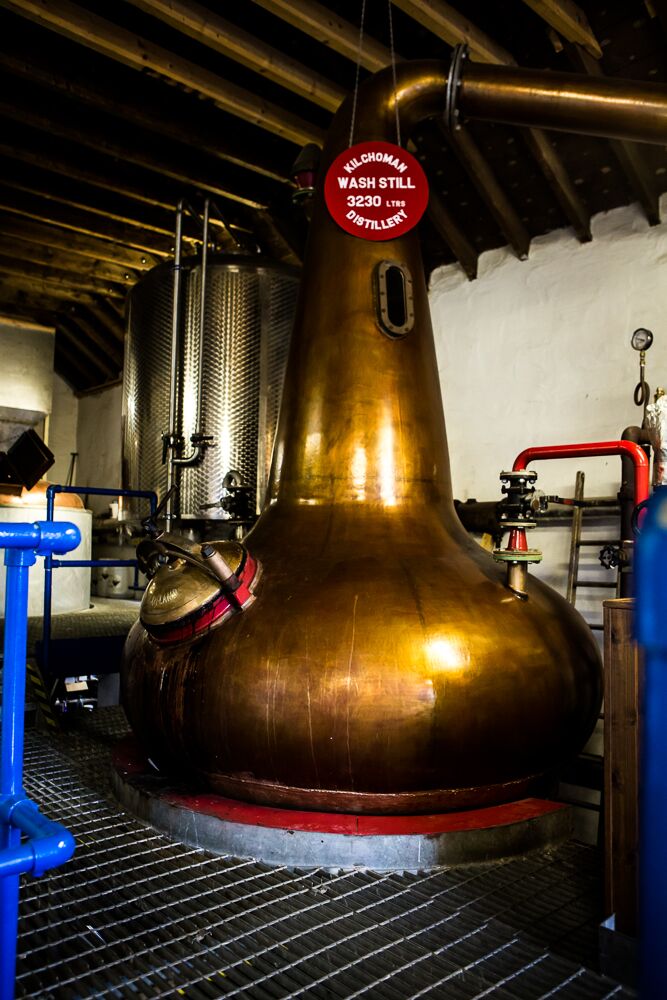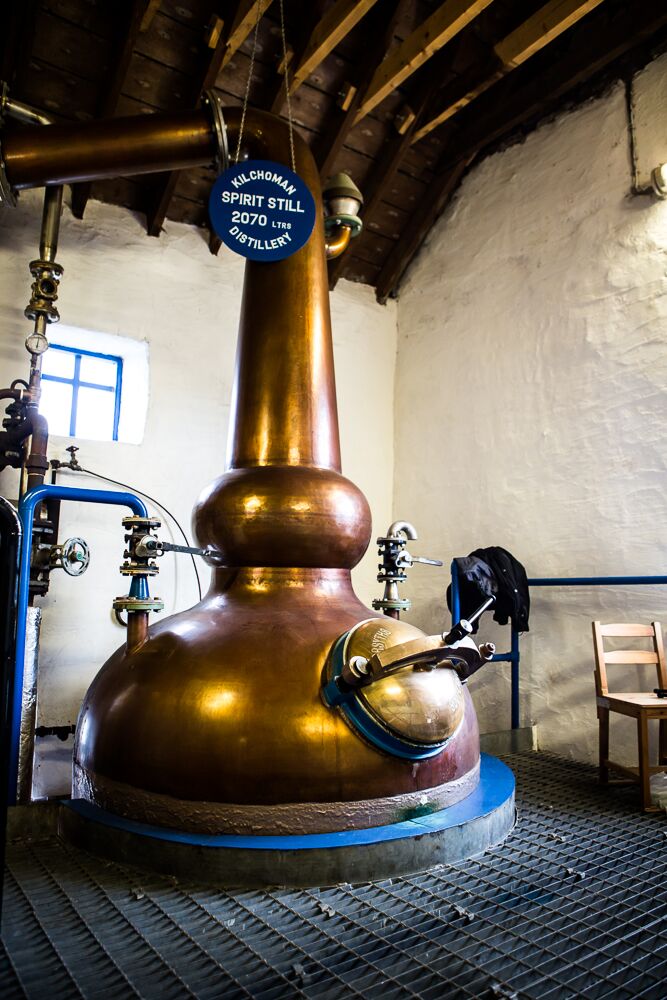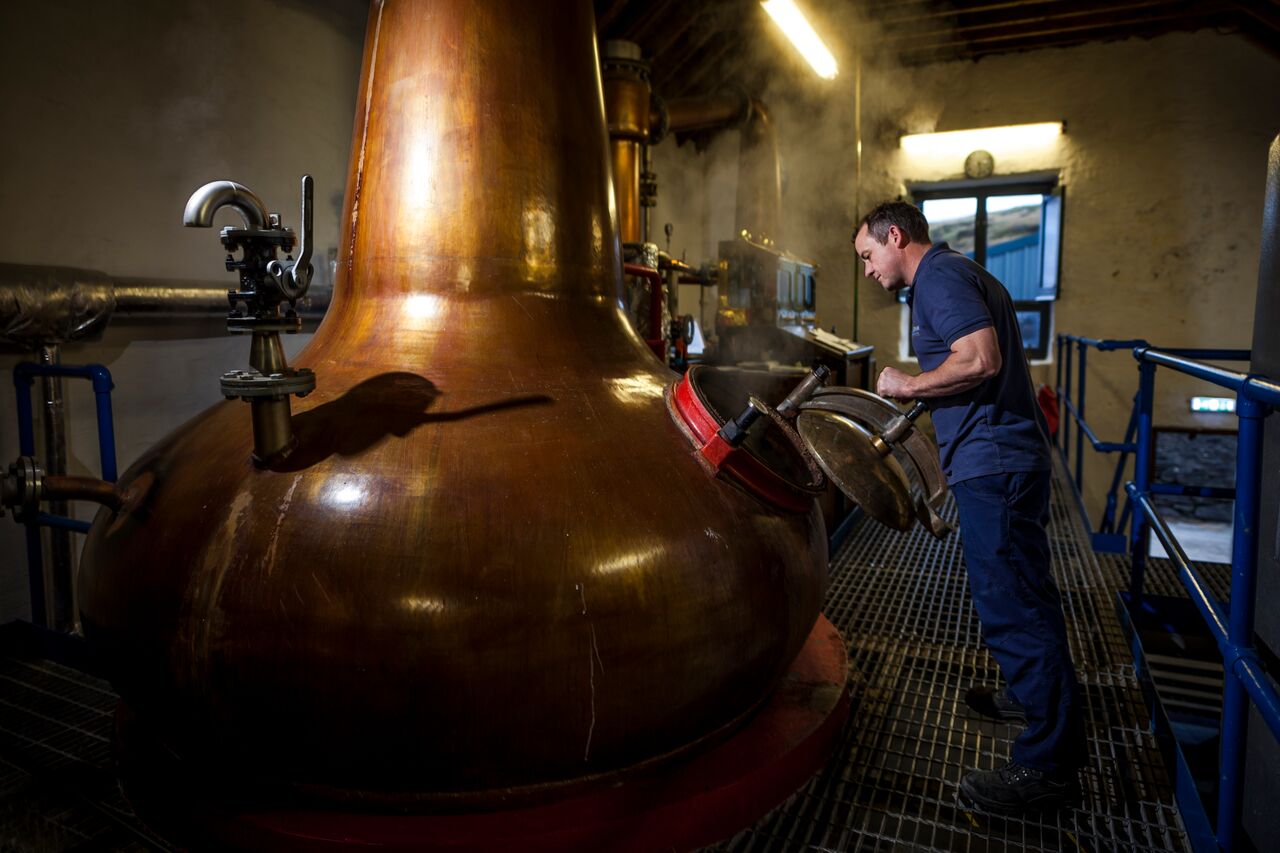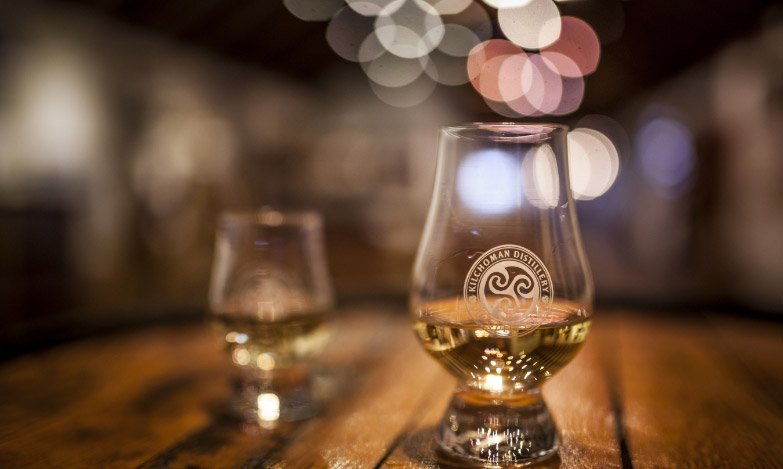BLOG POST
The Science of Pot Stills
August 22, 2018At Kilchoman distillery we have two pot stills, our wash still and our spirit still. From these stills we are able to create something very unique and powerful; our new make spirit. Kilchoman new make spirit is light and floral, like magic in a glass. The question is however, how are we able to create this magic?
An overview of distillation
After our barley is grown, harvested, malted, peated, dried, mashed and fermented, it’s finally ready for the process of distillation. The first stage is to add the wash from the previous step into a large pot still called the wash still. These are normally handmade from copper and heated from below, vaporising the liquid into a fine alcoholic mist – a product reminiscent of the foggy Islay clifftops looming outside. This then rises up the neck of the still where it condenses into a liquid called ‘low wines’, at around 25% alcohol by volume. Enough to get you stumbling, sure, but it’s not a something we would advise on drinking! At Kilchoman, 3000 liters of wash is pumped into the wash still, from this only 1000 liters will become low wines, the rest is pot ale (which we use as fertiliser on our barley fields.)
Since the low wines themselves are frankly undrinkable, the still men move it into a second, smaller still called the spirit still. When heated, the alcohol rises much like an actual spirit, and separates out into three phases of which only the middle phase is deemed good enough to be collected for maturation. This forms the ‘heart’ of the whisky and is taken to our filling store to be filled into casks for maturation in one of our four dunnage warehouses. Meanwhile, the early (foreshots) and late phases (feints) are mixed into the next batch of low wines ready for another round of distillation. From the 3000 liters of wash that we start with at kilchoman, only 300 liters of new make spirt is created.
The wash still
The beauty of the pot still is that it helps to keep the flavor of the mash, unlike the reflux stills used for vodka or rum. The shape of the wash still is fairly generic, from distillery to distillery the wash still will look the same but will most likely differ in size. At this stage, the wash still doesn’t necessarily have an influence on the character of our end spirit.
The spirit still
The spirit still is the smaller of the two, and the most important when it comes to creating the fundamental flavors that define a whisky. The neck shape is a key component, as is the overall size. Kilchoman Distillery use a 2070 liter still with a relatively tall, narrow neck. While this might sound large it’s remarkably small compared to some distilleries which are home to pot stills over ten times the size. At Kilchoman we have a tall narrow neck on our spirit still and we distill slowly thus giving us our unique light floral spirit. The reflux bulb (or boil bulb) on our still aids the purification of the spirit, this is where vapor can circulate and interact with the copper for longer, removing more unwanted compounds and resulting in a more defined flavor. The spirit must work harder to climb up the neck, the more difficult the spirit finds it to rise up the still, the lighter our spirit will be, this is what gives us our unique clean, light and fruity spirit. Therefore, the larger the reflux bulb the lighter and fresher your spirit will be. There is no right or wrong, with each distillery looking to create their own unique whisky profiles, steeped in the traditions of their region. With different traditions come different pot stills.
Why copper?
Copper is a very important factor when it comes to the pot stills. The interaction between the copper and the liquid will purify the spirit, it will purify the low wines from the wash still and the spirit from the spirit sill. The copper component has a heavy influence in producing the end product of Kilchoman new make spirit. In fact, some pot stills are shaped to maximise copper contact at key points, with the belief that the flavor can be tweaked at just the right level. Copper is also a fine heat conductor, helping to distribute heat evenly.
‘Our copper stills produce our unique signature Kilchoman, light floral spirit’. (Anthony Wills, 2018 – founder of Kilchoman)
The Cut
Not all the spirit produced in the spirit still is worthy of the cask. As mentioned, three phases of spirit are produced, with the foreshots deemed to contain undesirable compounds. It’s the vital role of the stillman to determine the ‘cut’ of a whisky, only sampling that which contains the perfect balance. This normally takes years of training to truly master and varies from distillery to distillery depending on what a whisky means to them. Kilchoman spirit runs through a spirit safe and is cut early, from 75% abv to 65.5% abv with an average of 70%. This gives our whisky its unique and famous freshness. Other whiskies are cut later or over a wider range, giving them completely different properties – yet another reason that scotch whisky is so wonderfully varied.
The Stillman
The art of perfecting the cut requires intimate knowledge of the ingredients involved, from the freshly malted barley to the glistening spring water. Cut too early or too late and the impurities of the feints can throw off the balance of whisky. So, the stillman waits, and watches. The pot stills may be surrounded by science but this aspect of the distilling process is a very human art form. It’s why expertise and tradition go a long way to creating the best whiskies. Yes, it’s a long and taxing process, but given the magical results, its worth is known in the end.
‘Tradition makes the whisky, people make the spirit.’ (Islay Heads, 2018 – Distillery manager)
READ NEXT
NEW RELEASES
Machir Bay Cask Strength 2025
Three years since our last Machir Bay Cask Strength release, the 2025 edition is here, and it delivers in every sense. “One of my favourite whiskies we have released, it has everything I love about Kilchoman spirit, with a little extra punch. There will be a lot of happy Kilchoman…
November 4, 2025




